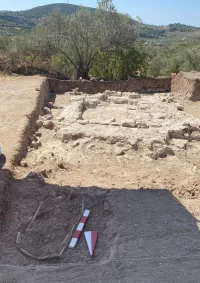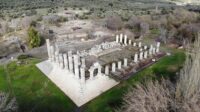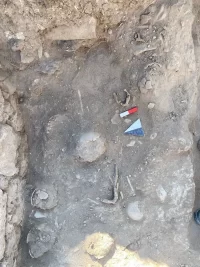 A preventative archaeology survey at the site of a solar panel system in Carcarello, a few miles from the ancient Etruscan city of Tarquinia in central Italy, has unearthed a necropolis from the Roman imperial era. The excavation has uncovered 57 burials dating between the 2nd and 4th centuries A.D., several of them richly furnished.
A preventative archaeology survey at the site of a solar panel system in Carcarello, a few miles from the ancient Etruscan city of Tarquinia in central Italy, has unearthed a necropolis from the Roman imperial era. The excavation has uncovered 57 burials dating between the 2nd and 4th centuries A.D., several of them richly furnished.
 The excavation conducted in March and April of 2023 brought to light a wide variety of tomb types including gabled roof tile tombs (known as “alla cappuccina” after the pointed hood of a Capuchin monk’s cowl), amphora burials, masonry coffins and simply earthen graves. Despite being found less than two feet under the surface, the burials had never been looted or damaged. The necropolis was protected by large limestone boulders that dotted the field, making it impossible to cultivate.
The excavation conducted in March and April of 2023 brought to light a wide variety of tomb types including gabled roof tile tombs (known as “alla cappuccina” after the pointed hood of a Capuchin monk’s cowl), amphora burials, masonry coffins and simply earthen graves. Despite being found less than two feet under the surface, the burials had never been looted or damaged. The necropolis was protected by large limestone boulders that dotted the field, making it impossible to cultivate.
 The graves contained the skeletal remains of 67 individuals as some of the 57 tombs were communal, built for at least two people who were either married couples or otherwise related. Some of them were buried clenched in an embrace.
The graves contained the skeletal remains of 67 individuals as some of the 57 tombs were communal, built for at least two people who were either married couples or otherwise related. Some of them were buried clenched in an embrace.
Silver rings with amber and engraved initials, precious stones, terracotta pottery, coins, shiny glasses, amulets and even items of clothing were found alongside the golden necklaces and earrings.
“We found several skeletons still wearing their expensive stockings and shoes,” Emanuele Giannini, lead excavation archaeologist at the site told CNN. “All these riches, and the fact that the bones show no sign of stress or physical labor, (leads us to believe) these weren’t local farmers, but upper-crust members of Roman families coming from cities.” […]
“We did have a faint idea that some treasure could lie there, as historical sources mentioned the location of a postal station for travelers near the site,” explained Giannini. “Many Romans would stop (here) for the night to eat and rest, but the magnitude of the discovery is unmatched.”
The diversity of funerary objects laid near the remains, and the luxurious designs and linings inside the tombs, have led archaeologists to believe that the occupants wanted to recreate heavenly spaces similar to their earthly homes. The interior of many tombs originally featured elaborate cloth linings, or were surrounded and covered by tiles or terracotta pieces like little houses.
 The artifacts recovered from the graves are undergoing conservation, and a selection of them went on display last month at the Castle of Santa Severa in Santa Marinella, 25 miles south of Carcarello. The skeletal remains are now being studied and will be analyzed to determine their geographic origins and any family relationships.
The artifacts recovered from the graves are undergoing conservation, and a selection of them went on display last month at the Castle of Santa Severa in Santa Marinella, 25 miles south of Carcarello. The skeletal remains are now being studied and will be analyzed to determine their geographic origins and any family relationships.












